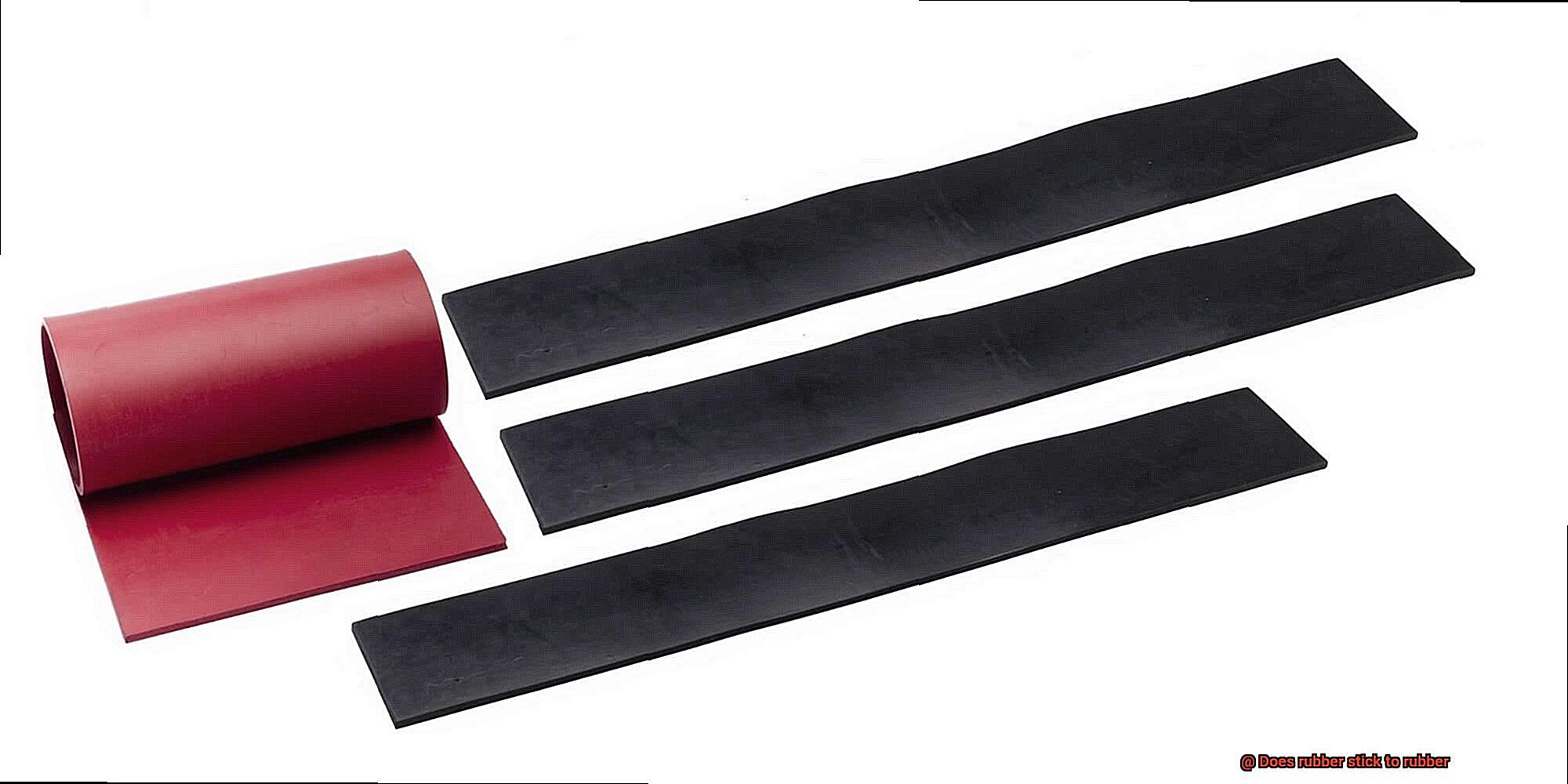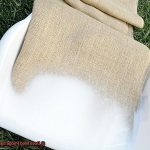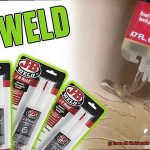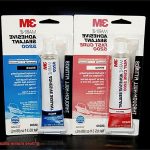We see it everywhere, from the bouncy balls we played with as kids to the rubber bands that hold our papers together. But here’s the burning question: does rubber stick to rubber?
It may sound like a no-brainer, but trust me, this is one sticky situation with a twist. So sit back, relax, and let’s unravel the mystery of whether rubber objects cling or slide apart.
Get ready for a wild ride into the captivating world of rubber and discover the truth about its bond with its own kind.
What is Rubber?
Contents
- 1 What is Rubber?
- 2 Adhesion Between Rubber Surfaces
- 3 Different Types of Rubber and Their Adhesive Properties
- 4 Surface Conditions and Adhesion
- 5 Additional Substances to Enhance Adhesion
- 6 The Role of Elastomers in Natural Rubber’s Sticking Ability
- 7 Synthetic Rubbers and Their Adhesive Properties
- 8 Contaminants and the Effect on Adhesion between Rubber Surfaces
- 9 Conclusion
Rubber, renowned for its elasticity and adaptability, is a captivating material that plays a pivotal role in diverse industries. But does rubber stick to rubber? In this article, we will unravel the mysteries of rubber and delve into its adhesive properties, exploring the factors that influence its stickiness.
Understanding Rubber:
Rubber, an elastomer, possesses the remarkable ability to stretch and revert to its original shape. Derived from natural sources like the sap of rubber trees or produced synthetically using petroleum-based materials or chemical compounds, rubber’s adhesive properties can vary based on its composition.
Factors Affecting Adhesion:
- Type of Rubber: Natural rubber, infused with elastomers, exhibits excellent adhesive characteristics when in contact with itself. Conversely, synthetic rubbers may not adhere as effectively due to their differing chemical compositions.
- Surface Conditions: The cleanliness and smoothness of surfaces greatly influence the interaction between rubber molecules, fostering robust bonds and increased adhesion. Rough surfaces or those contaminated with dust or oil can compromise adhesion.
- Additional Substances: Adhesives or bonding agents can be employed to enhance adhesion between rubber surfaces. These substances are specifically designed to create robust bonds and improve sticking properties. Selecting the appropriate adhesive for the type of rubber is crucial for optimal results.

Practical Applications:
The adhesive properties of rubber bear significant implications across various industries, including:
- Automotive: Adhesive bonding plays a vital role in tire manufacturing by ensuring a strong bond between the rubber tread and tire carcass.
- Construction: Rubber adhesives are indispensable for sealing applications, such as joining rubber gaskets or seals to create watertight connections.
- Manufacturing: Rubber-to-rubber adhesion is essential in producing products like conveyor belts, where a sturdy bond guarantees reliability and longevity.
Adhesion Between Rubber Surfaces
Rubber, that marvelously elastic material that seems to have a mind of its own, has captivated us for centuries. Its ability to bounce back and withstand pressure makes it a perfect choice for a wide range of applications. But when it comes to sticking rubber to rubber, things can get a little tricky.
There are several factors that come into play when considering the adhesion between rubber surfaces. One of the main culprits is the presence of contaminants or barriers on the surface. Picture trying to stick two pieces of tape together with dirt in between – it just won’t work. For optimal adhesion, rubber surfaces must be clean and free from any dirt, oils, or oxidation layers. So, before attempting to stick them together, make sure those rubber surfaces are squeaky clean.
Surface preparation is the key to achieving a strong bond between rubber surfaces. Techniques such as cleaning the surfaces with solvents or detergents, using abrasives like sandpaper to roughen the surface, or applying primers or bonding agents can significantly improve adhesion.
The type of rubber being used also plays a role in adhesion. Natural rubber, derived from latex obtained from certain trees, generally possesses good adhesive properties. Synthetic rubbers like neoprene and nitrile rubber also tend to have good adhesion characteristics. However, other types of rubber, such as silicone rubber or fluorocarbon rubber, may not adhere well without specialized adhesives.
Environmental conditions can also impact the adhesion between rubber surfaces. Temperature, humidity, and exposure to chemicals can all influence the adhesive strength. Rubber materials may undergo changes in their properties under different environmental conditions, which can affect their ability to stick together.
Different Types of Rubber and Their Adhesive Properties
Rubber, the material that can stretch and bounce back like no other, holds a secret – not all rubber sticks together in the same way. In this blog post, we will explore the different types of rubber and their adhesive properties when bonding to other rubber surfaces. Prepare to delve into the science behind rubber adhesion.
Natural Rubber:
When it comes to sticking to itself and other rubber surfaces, natural rubber takes the crown. Derived from the sap of rubber trees, this type of rubber boasts exceptional adhesive properties. Its high elasticity and tackiness allow it to form strong bonds. This makes it the perfect choice for manufacturing tires that grip the road with tenacity or creating industrial seals that maintain a tight seal.
Synthetic Rubber:
While natural rubber reigns supreme in adhesion, synthetic rubbers like neoprene and nitrile also possess good adhesive properties. Neoprene rubber, commonly used in gaskets and seals, adheres like glue to various materials due to its unique chemical structure. Nitrile rubber, often found in automotive applications, bonds well with different surfaces. However, silicone rubber is a bit of a rebel. With its low surface energy, it lacks stickiness when it comes to most substances, including other rubbers.
Specialty Rubbers:
In addition to natural and synthetic rubbers, there are specialty rubbers tailored for specific applications. EPDM rubber, for example, boasts excellent weather resistance and adheres well to surfaces such as metal and plastic. Butyl rubber is another star in the adhesive world. With its exceptional adhesion to metal surfaces, it is commonly used in sealing applications.
Adhesive Options:
To achieve a strong bond between rubber surfaces, selecting the right adhesive is crucial. Various adhesives like cyanoacrylate (super glue), epoxy, or rubber-based adhesives are specially formulated to work with rubber and ensure a durable bond. However, using the wrong adhesive can lead to a slippery situation. So choose wisely.
Factors Affecting Adhesion:
Surface preparation, temperature, and pressure all play a role in rubber adhesion. Properly cleaning and roughening the rubber surface can enhance adhesion. Extreme temperatures or insufficient pressure during bonding may result in weaker bonds. It’s like ensuring you have a clean canvas before creating a masterpiece.
Surface Conditions and Adhesion
Have you ever wondered how rubber surfaces stick together? It’s not as simple as slapping on some glue and hoping for the best. Achieving a strong bond between rubber surfaces requires careful consideration of various factors, including surface conditions, temperature, adhesive selection, and more. In this blog post, we will dive deep into the fascinating world of rubber adhesion and explore how these factors influence the stickiness of your everyday rubber items.
Surface Conditions: Cleanliness and Dryness are Key.
The key to successful rubber adhesion lies in the surface conditions. Before attempting to bond rubber surfaces, it is essential to ensure they are immaculately clean, bone dry, and free from any contaminants or oils. Even a thin layer of oxidation or contamination can hinder the bonding process, so it’s crucial to remove it beforehand. Purging any oils or contaminants on the surface using solvents like isopropyl alcohol or acetone is a game-changer. These solvents dissolve any unwanted substances, allowing for better adhesion.
Temperature: The Heat Factor
Believe it or not, temperature plays a significant role in rubber adhesion. Adhesives have specific temperature ranges within which they work optimally. It is vital to follow the manufacturer’s instructions regarding temperature requirements for achieving optimal bonding. Extreme temperatures can cause adhesive failure, so finding the right balance is key.
Adhesive Selection: Finding the Perfect Match
Not all adhesives are created equal when it comes to bonding rubber surfaces. Cyanoacrylate (super glue), epoxy, and silicone-based adhesives are commonly used for rubber-to-rubber bonding due to their unique characteristics and compatibility with different rubber types. Choosing the right adhesive for your specific application is crucial to achieving a strong and durable bond.
Additional Surface Preparation Techniques
In some cases, additional surface preparation techniques may be required for optimal adhesion. For example, if the rubber surface is smooth and non-porous, roughening it using sandpaper or a wire brush can increase the surface area and provide more contact points for the adhesive to bond. This simple step significantly enhances the bond strength between rubber surfaces.
Pressure and Curing Time: The Final Touch
Applying sufficient pressure during the bonding process to ensure good contact between the rubber surfaces is crucial. This maximizes the adhesive’s effectiveness and improves the overall bond strength. Additionally, allowing adequate curing time before subjecting the bonded rubber surfaces to any stress or load is essential. Rushing this step can result in premature adhesive failure.
Additional Substances to Enhance Adhesion
If you’ve ever wrestled with the challenge of getting two rubber surfaces to stick together, you know the struggle is real. Rubber’s elasticity and flexibility make it a bit of a tricky customer when it comes to adhesion. But fear not. There are some additional substances that can give you a helping hand in enhancing the adhesion between rubber surfaces.
One of these magical substances is adhesive primer. This secret weapon is applied to the rubber surfaces before you even think about reaching for the adhesive. It creates a chemical bond between the rubber and the adhesive, giving you a stronger hold. Think of it as a secret handshake between the rubber and the glue.
But wait, there’s more. For those looking for something more tailored to their specific needs, rubber bonding agents are here to save the day. These specially designed agents contain chemicals that react with the rubber surfaces, creating a bond that would make even superheroes jealous. Just like every superhero has their own unique powers, different types of rubber might require different bonding agents.
And let’s not forget about the adhesive itself. Certain types of adhesives can also enhance adhesion between rubber surfaces. Enter cyanoacrylate adhesives, better known as super glues. These bad boys have the power to bond different materials, including rubber. Just make sure you choose an adhesive that is specifically designed for bonding rubber to ensure optimal sticking power.
The Role of Elastomers in Natural Rubber’s Sticking Ability
Rubber’s ability to stick to surfaces is crucial in many applications, from repairing torn rubber soles to creating DIY projects. Elastomers, a type of polymer that stretches and returns to its original shape, play a significant role in natural rubber’s sticking ability. The molecular structure of elastomers allows them to conform and adhere to different surfaces, making natural rubber adhesive.
The molecular structure of elastomers is characterized by long polymer chains that are highly flexible. These chains contain chemical bonds that enable them to form intermolecular interactions with other substances. One crucial intermolecular interaction is Van der Waals forces, weak attractive forces that exist between all molecules. Van der Waals forces create a weak bond between the polymer chains of elastomers and the surface they come into contact with, enhancing their sticking ability.

Another unique characteristic of elastomers is their ability to absorb energy without permanent damage. When two pieces of rubber come into contact, the elastomers in each piece can deform and absorb energy. This allows them to conform and adhere to one another effectively. The energy absorption capabilities of elastomers contribute to the adhesive properties of natural rubber.
Furthermore, elastomers provide natural rubber with its tackiness, which refers to its stickiness or adhesive quality. Elastomers enable natural rubber to flow and conform under pressure or when heated. This enhances its ability to adhere to surfaces, especially when pressure or heat is applied.

While elastomers are crucial for natural rubber’s sticking ability, other factors can also influence adhesive strength and durability. Additives or fillers, surface roughness, and temperature and humidity conditions all play a role in the effectiveness of adhesive bonds formed between rubber surfaces.
Synthetic Rubbers and Their Adhesive Properties
Synthetic rubbers, also known as elastomers, are renowned for their exceptional elasticity and durability. However, their adhesive properties are equally remarkable and make them highly sought after in various industries, including manufacturing, construction, and automotive. In this article, we will delve into the adhesive properties of synthetic rubbers and highlight the advantages of using synthetic rubber adhesives in these industries.
Styrene-Butadiene Rubber (SBR):
- SBR exhibits excellent abrasion resistance and remains flexible even at low temperatures.
- It demonstrates good adhesion to other rubber surfaces, ensuring secure bonding.
- Its exceptional properties make it ideal for tire manufacturing and bonding different rubber components reliably.
Neoprene:
- Neoprene offers outstanding resistance to weathering, ozone, and chemicals.
- It displays good adhesion to rubber surfaces, providing reliable bonding between rubber materials.
- Commonly used in gaskets, seals, and adhesives for creating durable bonds between rubber components.
Ethylene Propylene Diene Monomer (EPDM):
- EPDM is known for its excellent resistance to heat, weathering, and electrical insulation.
- It exhibits good adhesive properties to other rubber surfaces, facilitating secure bonding.
- Widely utilized in roofing membranes, automotive weatherstripping, and electrical insulation due to its resilience and ability to adhere well to other rubbers.
Silicone Rubber:
- Silicone rubber stands out for its exceptional heat resistance and flexibility across a wide temperature range.
- Specific silicone adhesives are available to effectively bond silicone surfaces together.
- These adhesives are formulated with special additives that enhance bonding strength between silicone rubbers.
Rubber-to-Rubber Adhesives:
- Specifically designed to create robust and long-lasting bonds between rubber materials.
- Formulated with chemical components that promote adhesion and enhance bond strength.
- Consider factors like rubber type, application requirements, and desired bond strength when selecting a rubber-to-rubber adhesive.
Synthetic rubbers possess adhesive properties that make them invaluable in a variety of industries. Their ability to adhere to other rubber surfaces enables secure bonding between different components.
Whether it’s SBR in tire manufacturing, neoprene in gaskets and seals, EPDM in roofing membranes, or silicone rubber in specialized applications, synthetic rubber adhesives offer durability, resilience, and excellent bond strength.
Contaminants and the Effect on Adhesion between Rubber Surfaces
In the world of adhesive bonding between rubber surfaces, a formidable adversary lurks in the shadows: contaminants. Like a superhero fighting against a supervillain, the presence of contaminants can weaken the adhesion between rubber surfaces and compromise the integrity of the bond. In this blog post, we will explore the impact of different types of contaminants on the adhesion between rubber surfaces and how these contaminants can affect bonding strength.
Oil: The Slippery Saboteur
Oil, one of the most common contaminants in industrial settings, is a notorious villain in adhesion. It acts as a barrier, preventing direct contact between rubber surfaces and impeding the formation of a strong bond. Its slippery nature exacerbates the problem, making it even harder for rubber surfaces to stick together.
Dirt and Dust: The Invisible Intruders
Although dirt and dust particles may seem harmless, they can wreak havoc on adhesive bonding. These tiny intruders get trapped between rubber surfaces, creating gaps and reducing the bonding area. As a result, adhesion strength is compromised, and the bond becomes weaker. Additionally, dirt and dust may contain moisture, which further weakens the bond and increases the likelihood of failure.
Chemical Reactions: The Transforming Troublemakers
Some contaminants have the ability to react with rubber surfaces, causing degradation and altering their properties. Certain chemicals or solvents can make rubber brittle or change its physical characteristics.
This chemical transformation weakens both the rubber itself and its ability to adhere to other rubber surfaces, compromising adhesion strength and potentially leading to failures.
Specialized Solutions: Overcoming Contaminant Challenges
Fortunately, not all hope is lost in the battle against contaminants. Some adhesives are specifically formulated to combat the inhibiting effects of contaminants. These adhesives contain special additives or primers that can overcome the barriers posed by oil, dirt, or even chemical reactions. By using these specialized solutions, it is possible to achieve strong adhesive bonds between rubber surfaces, even in the presence of contaminants.
5ecE-EiZruY” >
Conclusion
In conclusion, the bond between rubber surfaces is influenced by a multitude of factors. Surface conditions, temperature, adhesive selection, and the presence of contaminants all come into play. To achieve a robust connection between rubber surfaces, it is crucial to ensure that they are pristine – devoid of any oils or contaminants and thoroughly dry. Elevating adhesion levels can be accomplished through surface preparation techniques such as solvent cleaning or roughening.
The type of rubber utilized also impacts adhesion. Natural rubber boasts exceptional bonding properties due to its elastomers when in contact with itself. Synthetic rubbers like neoprene and nitrile exhibit commendable adhesion characteristics as well. However, some types of rubber necessitate specialized adhesives for optimal bonding.
To enhance adhesion further, additional substances like adhesive primers and bonding agents can work wonders. These substances forge chemical bonds between the rubber and adhesive, bolstering sticking power. Selecting the appropriate adhesive for each specific application is paramount to achieving a bond that withstands the test of time.
Contaminants like oil, dirt, and chemicals have the potential to weaken the bond between rubber surfaces. Fortunately, specialized solutions such as additives or primers can surmount these challenges and ensure unwavering bonds even in their presence.
Gaining an understanding of the factors influencing rubber-to-rubber adhesion proves indispensable across various industries where reliable bonding between rubber materials is imperative.





